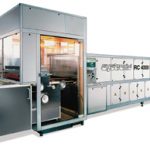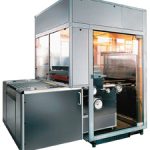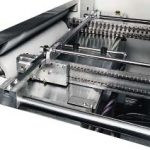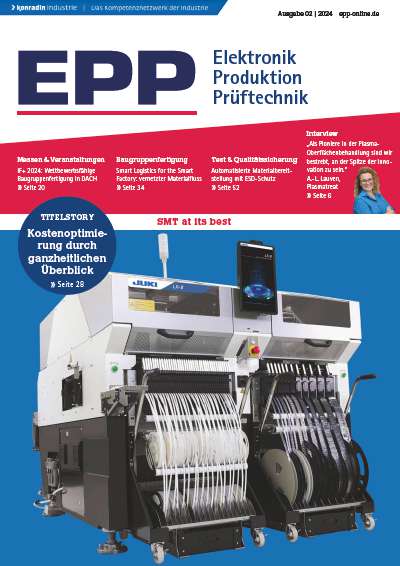Liquid resists for primary imaging of PCB inner layers has become a widely established and effective alternative to dry film within the past two to three years. Here, we will have a look on innovative equipment design which is used for double-sided roller coating.
Ken Gaglione, Systronic North America
The conversion from dry to liquid technology has been gradual, with the main impetus for change being the promise of lower fabrication costs and improved resolution capabilities. Industry acceptance has been cautious, and largely hinged on a few large volume manufacturers implementing in their domestic operations in addition to the widespread use overseas.
Critical to this has been the near constant evolution of resist and equipment design surrounding liquid imaging. The goal for equipment and resist manufacturers has been to develop a system package economically and operationally attractive enough to compete with well-established dry film lamination techniques. In many cases, this has meant converting imaging operations from a „dry to wet“ mindset with all the attendant problems – real and perceived – that involves.
After many years of development, and some high profile successes and failures, liquid resist is now being packaged in a way that makes it attractive to even moderate volume users without major capital investment or extended payback periods. Resist and equipment types are more sophisticated and provide the fabricator an unprecedented choice. Liquid resist is offered in both positive and negative acting versions exposed with conventional equipment or direct-write laser equipment requiring artwork.
Equipment choices have evolved from screening tables, a dip tank, spraying, electrophoretic deposition, curtain coating and double-sided roller coating. Of these, double-side roller coating has become the most widely accepted method for resist application in terms of number of units in production and amount of square feet processed. Prescriptions for choosing the right chemistry are provided in detail elsewhere, but relatively little attention has been paid to the advancements in double-sided roller coating that has led to its broad basedacceptance.
The imaging process
Liquid processes largely consist of the same steps as dry film lamination, such as precleaning of core material, resist application, imaging, and developing, etching and stripping. The main difference in a liquid installation is the addition of a drying oven after coating to fully dry the resist by extracting carrier solvents before subsequent handling and imaging.
The next most important are of process difference is in handling. Since liquid resists do not use coversheets, they are exposed to handling damage, and additional care is usually taken to observe resist manufacturers limits on stacking, hold times, and vacuum during exposure conditions. The ideal process is the „just-in-time“ model that takes coater layers immediately from the oven by conveyor to the exposure station and then further with minimal handling.
Important changes must also be made to optimize both exposure settings, and in the developing and etching processes to account for the much thinner resist and higher resolution capabilities. With some resists today requiring less than 25mJ/cm2 of exposure energy, this can mean speeding up these processes considerably.
Roller coating evolution
Roller coating has been adopted from profligate use in the wood industry where it is used for coating adhesives and other materials. The first attempts to use roller coating for PCB fabrication in the early seventies met with only limited success due unfamiliarity of the industry with liquid imaging and the relative ease and popularity of dry film imaging. Still, as the threat/promise of finer lines and spaces loomed larger, the pressure remained on suppliers to invest in developing this alternative technique. Some large PCB fabricators did successfully adopt liquids for production, but these early systems were 100% solids and required large towers for off-contact printing.
Since the early nineties, leading equipment suppliers have teamed with resist suppliers to offer the black-box approach to liquids. That is a completely integrated coating, drying and handling system offered together with a compatible resist. This approach removed much of the burden from manufacturers to evaluate elements individually and to be responsible should one or more of the components not properly support the entire system function. Price and resolution demands on PCB fabricators throughout the nineties rekindled interest, and the advent of the modern liquid age was born with more than 80 unique lines being installed since 1992.
Method of coating
Double-sided roller coating means both sides of the inner layer are coated simultaneously by extrusion through two grooved rubber rollers saturated with resist (figure 1). Resist is filled into the grooves by first filling the gap between the doctor roller and the rubber roller. The doctor roller simply applies pressure to the rubber roller and removes excess resist prior to coating. A mirror image process occurs on the bottom roller.
The rubber is usually vulcanized and precision ground to produce V-shaped channels to the specific depth and density required to produce a nominal 12 micron coating. These specifications depend on the resist type to be processed, and some newer resists require even less than 12 microns for successful coating. A common measurement is the number of tracks per inch (TPI) in the roller, (a TPI of 48 is common).
Drying under cleanroom conditions
Coating in this fashion requires special handling since both sides are wet, and all steps must be taken to avoid particulate contamination in the wet coating that can lead to subsequent opens or shorts during developing. A fully integrated oven is desirable, and one that includes a self-contained cleanroom environment surrounding the coater and oven entrance. In this fashion, lacquered inner layers enter the oven immediately following coating, and are processed in a controlled atmosphere.
A typical oven for this purpose uses a pin-and-chain system that literally grips the incoming layer along the edges, and carries it into the process zones of the oven. The orientation of the chain in the oven, the type of heat system used (convection, infrared or some of both), the air flow magnitude, velocity and direction at the different drying stages all play important roles in successful defect-free coatings.
Controlling the exhaust and intake air supply is important to a uniform coating. This generation oven has two independent heating zones for flash-off and heating that use directed air from the cooling end of the machine toward the entrance end. In this way, hot air from the process zone cannot enter the cooling zone and condense, and this also provides a more rapid transfer of heat into the substrate. This is accomplished using high-velocity air nozzles spaced evenly throughout the process zone, but far enough apart from the tack zone so as not to disturb the coating during the critical first few moments of drying time.
The oven described here uses only convection heat withinduct heaters. This innovation has three important benefits: First, it completely avoids IR emitters, which have been shown to produce varying results when the surface reflectivity of the copper beneath the resist changes, for example double or single-treated oxide coatings. Second, convection heat also has the advantage in that it can dry resist coatings in a wider process window, thereby producing greater operating latitude at lower overall surface temperatures. This becomes an important consideration when subsequent stacking operations are needed, and varying core thickness with their corresponding heat capacities are used in succession. In fact, the oven requires only 70kW of power to operate – significantly less power than earlier generations. And third, lower operating temperatures mean that the oven size can be reduced, thereby saving valuable floor space without sacrificing throughput .
Ongoing development
Liquid resist systems have evolved into production-proven means for improving resolution capabilities in inner layer imaging while simultaneously lowering material costs. Over the past five years, systems have become more like black-box processes that are now free from the integration problems that plagued earlier solutions. In some cases, resist and equipment suppliers have teamed-up to ensure that a complete approach to the process is obtained.
Critical to the application of the systems is ongoing equipment development. A new roller coater system offering a wider operating window than ever before possible is suitable for many different resist types. This allows the user freedom of mask choice while lowering operating power consumption, floor space, and infrastructure demands. This system relies on forced convection for thermal transfer and does away with the exigencies of infrared radiation heat.
Converting an existing dry film operation to liquid resist imaging requires careful consideration of all the benefits and costs associated with adopting the new methodology. With the leveraging of equipment and resist innovations, the benefits of liquids are better to use and are available to a greater number of fabricators.
Fax +49-7131-5849-90
EPP 154
zusammenfassung
Für das Beschichten von Innenlagen zum Multilayer-Aufbau ist die doppelseitige Flüssigbeschichtung mit Roller-Coater eine Alternative zur Verwendung von Trockenfilmresist. Bei Anwendung kompletter Anlagen mit integriertem Trockenofen ergeben sich sowohl Kostenvorteile als auch bessere PCB-Eigenschaften wie höhere Auflösung.
Résumé
L’application liquide double face avec un Roller-Coater représente une alternative à l’utilisation de film sec pour la réalisation de couches intérieures dans la technique multicouche. Le recours à des installations complètes intégrant le four de séchage apporte aussi bien des avantages au niveau des coûts que de meilleures caractéristiques PCB comme une résolution supérieure.
Sommario
Unsere Webinar-Empfehlung
Die 3D-Messung und Inspektion des Lotpastendrucks ist ein wichtiges Qualitätswerkzeug. Dieses funktioniert nur mit den richtigen Toleranzen und Eingriffsgrenzen.
Teilen:






.png)







